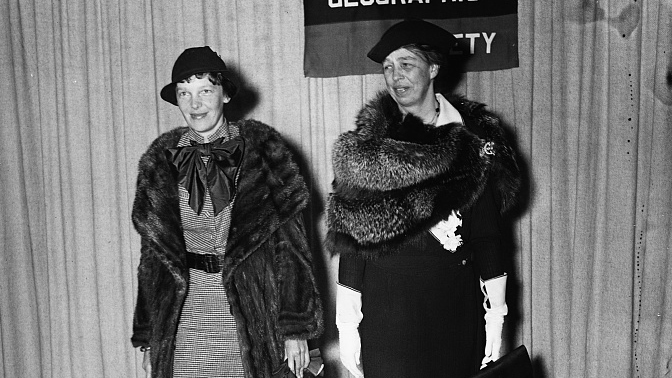On the night of April 20, 1933, Amelia Earhart made headlines when she and First Lady Eleanor Roosevelt took a bold detour from a formal dinner at the White House. Seeking a break from political conversations, the duo made their way to a nearby airport, where they commandeered a Curtiss Condor biplane. Still dressed in evening gowns and gloves, they soared to Baltimore, demonstrating Earhart’s adventurous spirit. Following the flight, Roosevelt remarked to the Baltimore Sun, “It does mark an epoch, doesn’t it, when a girl in an evening dress and slippers can pilot a plane at night.”
This episode is emblematic of Earhart’s quest for adventure and her commitment to women’s rights. She aimed to be the first female pilot to circumnavigate the globe, a dream that tragically ended on July 2, 1937, when she, her navigator Fred Noonan, and their Lockheed Electra disappeared over the South Pacific. A new search for the missing plane is set to commence on November 4, 2023, when a team from Purdue University embarks on an expedition to the remote Republic of Kiribati.
Earhart’s connection to Maryland is significant, as she frequently visited the state, including her first arrival on the Eastern Shore. A 1929 front-page story from the now-defunct Wicomico News recounts her invitation to a dinner in her honor at the Wicomico Hotel. Local pilot Forrest Wenyon flew her to a now-closed airfield near Salisbury, where her arrival captivated the town. “All are anxious and excited to see the first woman flyer to cross the Atlantic Ocean,” the article noted, highlighting the enthusiasm around her visit.
In 1932, Earhart became the first woman to fly solo across the Atlantic, a milestone celebrated at the Smithsonian National Air and Space Museum, where her Lockheed 5-B Vega is now on display. She returned to Baltimore multiple times, including on March 4, 1933, when she landed at Logan Field. At a dinner that evening, she noted the dramatic increase in female pilots, saying, “The number of women flyers has increased from 12 in January 1929 to 200 today.”
Earhart’s influence continued in Maryland, where her legacy is preserved through various initiatives. The Glenn L. Martin Maryland Aviation Museum features exhibitions on her contributions to aviation, while the College Park Aviation Museum offers educational experiences focused on her life. Additionally, a mural in Saint Helena commemorates her visits, and a play titled “When She Had Wings” debuted in Bethesda in 2015, showcasing her impact on women’s aviation.
Maryland also boasts dedicated researchers studying Earhart’s mysterious disappearance. The late Frank Benjamin argued that Earhart and Noonan may have crashed on a reef and been captured by Japanese soldiers. Another enthusiast, Bill Snavely, hosts a podcast titled “Chasing Earhart,” proposing that they turned back due to adverse conditions shortly after takeoff from Lae, New Guinea.
Perhaps the most enduring aspect of Earhart’s legacy in Maryland is her influence on women’s aviation. She served as the first president of the Ninety-Nines, an international organization dedicated to supporting female pilots. The Maryland chapter, established in 1929, remains active. Recently, the group hosted an introductory event in Easton, where sixteen women explored aviation and took flights in small planes. Former chapter president Jane Toskes noted that many participants were inspired by Earhart’s story, with some considering flight school.
Amelia Earhart’s adventurous spirit and pioneering achievements continue to inspire new generations of female pilots. Her legacy is woven into the fabric of Maryland’s aviation history, where she is celebrated not just for her flights, but also for her role in empowering women in a field that remains dominated by men. As Toskes reflects, “At this point, it’s hard to separate her legend from anything else that might have inspired you to start. People definitely get inspiration from her.”
